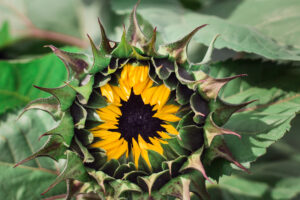Ornamental sunflower (Helianthus annuus) are grown as cut flowers due to their iconic appearance, vibrant colors, and ability to bring a long-lasting touch of sunshine to any floral arrangement. Cut sunflowers are versatile and can be used in a variety of floral arrangements. They make stunning standalone bouquets or can be combined with other flowers, foliage, or filler materials to create mixed arrangements. Sunflowers are beloved cut flowers that symbolize positivity, happiness, and adoration. They express love, loyalty, and joy, making them ideal for conveying warm sentiments on diverse occasions.
Sunflower plants can vary in height depending on the specific cultivar and growing conditions. They can range from dwarf varieties that reach around 1 to 2 feet (30 to 60 cm) tall to taller varieties that can grow up to 6 feet (180 cm) or more. The stem is sturdy and can be covered in coarse hairs. The leaves are typically large, broad, and heart-shaped with a rough texture. They are arranged alternately along the stem.

Sunflowers produce large, daisy-like flowers with a prominent central disk surrounded by petals. The petals can be found in various colors, including shades of yellow, gold, orange, red, and even bi-colored or multicolored varieties. The flower heads can range in size from a few inches to over a foot in diameter. This plant typically blooms during the summer and early fall, though specific blooming times can vary depending on the cultivar and growing conditions.
Cultivars of Sunflower Used as Cut Flowers
Numerous cultivars of ornamental cut sunflowers are available, each with unique characteristics and qualities. Here are some popular cultivars:
‘Teddy Bear’:
A dwarf variety with fluffy, fully double, golden-yellow blooms resembling large pom-poms. Approximately 1 to 2 feet (30 to 60 cm).

‘Sunrich’:
A series of sunflowers with branching habits and multiple blooms per stem. Available in various colors, including yellow, orange, and red. Typically 3 to 5 feet (90 to 150 cm), height depending on the specific variety.
‘Prado Red’:
A striking sunflower cultivar with dark burgundy-red petals surrounding a dark center. Adds a bold and dramatic touch to floral arrangements. Around 3 to 4 feet (90 to 120 cm) tall.

‘ProCut’
The ProCut series is a popular group of sunflower cultivars specifically bred for cut flower production. These cultivars are known for their long stems, large and uniform blooms, and extended vase life. This comes in different colors like orange, red, lime, white nite, and several other bi-colors.
‘Pastiche’:
This unique sunflower variety features bi-colored blooms with creamy-white petals and a dark center. The contrast between the petals and the center creates an eye-catching effect. This cultivar is usually 3 to 4 feet (90 to 120 cm) tall.

‘Autumn Beauty’:
A mix of sunflowers in various warm shades, including gold, bronze, and mahogany. The blooms vary in size and petal shape, creating an attractive and diverse display. Typically have 4 to 6 feet (120 to 180 cm) height.

‘Soraya’:
This variety is known for its rich, golden-yellow petals and dark center. ‘Soraya’ is also known for its long vase life and is a favorite for cut flower arrangements. Around 5 to 6 feet (150 to 180 cm) tall.
‘Giant Sungold’:
As the name suggests, ‘Giant Sungold’ produces large, golden-yellow blooms that can reach impressive sizes. It is known for its vigor and abundant flower production. Generally 5 to 7 feet (150 to 210 cm) tall.
‘Italian White’:
This cultivar features creamy-white petals and a contrasting dark center. Its elegant and sophisticated appearance makes it a popular choice for weddings and formal arrangements. Typically have 5 to 6 feet (150 to 180 cm) height.
These are just a few examples of ornamental cut sunflower cultivars available in the market. When selecting a cultivar, consider factors such as bloom size, color, height, and overall aesthetics to choose the ones that best suit your preferences and design requirements.

Sunlight Requirement
Ornamental sunflowers, like other sunflower varieties, thrive in full sunlight. They require a minimum of 6 to 8 hours of direct sunlight per day to grow and develop properly. These plants are known for their heliotropic nature, which means they track the movement of the sun across the sky. This characteristic allows them to maximize their exposure to sunlight throughout the day.
When selecting a location for your sunflowers in the garden, choose an area that receives ample sunlight and is not shaded by trees, buildings, or other structures. Adequate sunlight is essential for this plant to produce vibrant flowers and sturdy stems.
If you have limited sunlight in your garden, consider choosing dwarf or shorter sunflower varieties that are specifically bred to tolerate partial shade. These varieties can handle a few hours of direct sunlight along with some indirect or filtered light.

Temperature & Humidity Requirements
Sunflowers grown as cut flowers have specific temperature and humidity requirements to ensure their optimal growth and longevity.
Sunflowers thrive in moderately warm to hot temperatures. The ideal temperature range for their growth is between 70°F (21°C) and 78°F (26°C). These temperatures provide the best conditions for sunflowers to develop strong stems and vibrant blooms.
Heat tolerance: Sunflowers are generally tolerant of high temperatures, but they may require extra care during heat waves or prolonged periods of extreme heat. Providing sufficient water and shade during the hottest parts of the day can help prevent heat stress.
Sunflowers prefer moderate humidity levels. Ideally, the relative humidity should be between 40% and 60%. This range helps prevent excessive moisture that can lead to fungal diseases, but it also ensures the plants do not become too dry.
Good air circulation is crucial to prevent humidity from accumulating around the sunflowers’ foliage and flowers. Adequate airflow helps reduce the risk of fungal infections and encourages healthy plant growth.
Soil Requirements
Sunflowers prefer well-drained soils with good fertility. They can thrive in various soil types, including loam, sandy loam, or clay loam. The soil should be loose and friable, allowing for easy root penetration. They prefer slightly acidic to neutral soil pH levels ranging from 6.0 to 7.5. Conduct a soil test to determine the pH of your soil and make necessary adjustments if needed.
Adding organic matter before plantation, such as compost or well-rotted manure, can improve soil structure, fertility, and water-holding capacity. Before planting prepare the soil by removing any weeds, rocks, or debris. Loosen the soil to a depth of 8 to 12 inches (20 to 30 cm) using a garden fork or tiller. This will facilitate root development and nutrient uptake. Proper soil drainage is crucial for sunflowers. Ensure that the soil does not become waterlogged, as excessive moisture can lead to root rot and other issues.

Nursery Preparation
When growing sunflowers for cut flowers, starting with healthy nursery seedlings or preparing your seedlings is a great way to ensure a successful and productive crop.
Select sunflower varieties specifically bred for cut flower production. Look for varieties known for their long stems, large blooms, and extended vase life. Some popular cut flower sunflower varieties include ‘ProCut’ series, ‘Sonja’, ‘Sunrich’, and ‘Velvet Queen’.
Start your seedlings indoors about 4-6 weeks before the last expected frost date in your area. This will give your seedlings a head start and allow you to transplant them into the garden at the appropriate time.
Fill seedling trays or small pots with a high-quality seed starting mix. Place one seed about an inch deep into each container and cover it with the soil mix. Water the soil lightly after sowing the seeds.
Seeds germinate best in a warm environment. Maintain the temperature around 70°F (21°C) to encourage prompt and successful germination. You can use a seedling heat mat or place the trays in a warm area of your home.
Seeds require ample light for healthy growth. Place the seedling trays in a sunny location or provide them with 12-16 hours of fluorescent grow lights each day. Keep the soil evenly moist but not waterlogged to prevent the rotting of the seeds or seedlings.

When the seedlings have developed two to three sets of true leaves, they are ready for transplanting. Harden off the seedlings by gradually exposing them to outdoor conditions over the course of a week. Choose a location in your garden that receives full sunlight and has well-draining soil.
Depending on the variety, space your sunflower seedlings 12 to 24 inches apart to allow ample room for growth.
Water the transplanted seedlings thoroughly and continue to keep the soil consistently moist but not waterlogged. Apply a balanced fertilizer according to the package instructions to provide the seedlings with the necessary nutrients.
By following these steps, you can establish healthy sunflower seedlings for your cut-flower garden. Starting with strong nursery seedlings or preparing your seedlings ensures a successful start and increases your chances of obtaining high-quality blooms for cutting.
Water Requirements of Sunflower
Sunflowers require consistent soil moisture to thrive. Keep the soil evenly moist, but avoid overwatering, as waterlogged soil can lead to root rot. Aim for soil that is slightly damp but not saturated. When you water your sunflowers, provide a deep watering to ensure that the moisture reaches the root zone. Watering deeply encourages the roots to grow deeper into the soil, promoting a stronger and more stable plant.
The frequency of watering will depend on various factors such as climate, soil type, and weather conditions. As a general rule, check the soil moisture regularly by inserting your finger about an inch into the soil. If it feels dry at that depth, it’s time to water. During hot and dry periods, sunflowers may require watering every 2-3 days, while in cooler weather, watering once a week may be sufficient. Applying a layer of organic mulch around the base of sunflower plants can help conserve moisture in the soil by reducing evaporation.
Avoid watering the foliage and flowers of sunflowers from overhead. Wet foliage can increase the risk of fungal diseases. Instead, water at the base of the plant or use drip irrigation or soaker hoses to deliver water directly to the root zone.
Remember that individual environmental conditions and soil types can influence the watering needs of sunflowers. Monitor your plants closely and adjust your watering routine accordingly to maintain optimal moisture levels for healthy growth and extended vase life.
Nutrients requirement
When growing ornamental sunflowers for cut flowers, it’s important to provide them with proper nutrition through fertilization.
Before planting your sunflowers, amend the soil with organic matter such as compost or well-rotted manure. This helps improve soil fertility and provides a good foundation for your plants. Prior to planting, you can also incorporate a balanced slow-release granular fertilizer into the soil according to the package instructions. This will provide a steady supply of nutrients to the sunflowers as they grow.
Sunflowers are heavy feeders, especially when they are grown for their flowers. To promote healthy foliage and vigorous growth, use a fertilizer that is higher in nitrogen (N) content. Look for a fertilizer with a higher first number in the N-P-K ratio, such as 10-5-5 or 20-10-10. Apply the nitrogen-rich fertilizer every 3-4 weeks during the growing season. Phosphorus (P) and potassium (K) are essential for flower production. Look for a fertilizer with a higher second and third number in the N-P-K ratio, such as 5-10-10 or 10-20-20. Start applying this type of fertilizer when the plants start to develop flower buds and continue until the flowering period.
If you prefer organic options, you can use well-composted manure, fish emulsion, or seaweed-based fertilizers. These organic fertilizers provide a range of nutrients and micronutrients that support plant growth and flower development.
Remember to monitor the health of your sunflowers throughout the growing season. If you notice any signs of nutrient deficiency or excess (such as yellowing leaves or stunted growth), adjust your fertilization accordingly.
Staking of Cut Sunflower
Staking cut sunflowers is an important practice to ensure their upright growth, prevent them from bending or breaking, and maintain their aesthetic appeal. It’s best to stake sunflowers at an early stage of their growth, ideally when they are around 1 to 2 feet (30 to 60 cm) tall. This allows you to provide support before they become too tall and potentially become vulnerable to wind or heavy flower heads.
To support sunflower plants as cut flowers, choose sturdy bamboo or wooden stakes at least 1 inch thick and 4 to 6 feet tall. Insert stakes 1 foot deep, slanting away from the plant to create a V-shaped structure. Secure the sunflower stems to the stakes with soft, flexible ties like twine or cloth, ensuring they are not too tight. Regularly check and adjust ties as the sunflowers grow to provide adequate support without restricting growth.
Staking cut sunflowers with a net provides effective support, preventing bending or falling. Choose a lightweight nylon netting. Install tall, sturdy posts around the sunflower bed or rows. Attach the netting to the posts using twine or clips, ensuring it is taut. Guide the sunflower stems through the netting as they grow. The netting provides reliable support, keeping the stems upright and preventing leaning or falling.
By staking cut sunflowers, you can enhance their overall appearance, prevent them from toppling over, and maintain their beauty and integrity. Staking is particularly crucial for tall sunflower varieties or when growing sunflowers in windy locations. Proper support allows the sunflowers to stand tall and proud, showcasing their magnificent blooms in all their glory.

Harvesting
Harvesting cut sunflowers at the right time is crucial to ensure their optimal vase life and maintain their freshness. Choose the right time to harvest the sunflowers. Wait until the flower heads have fully opened and the petals are at their brightest and most vibrant color. Avoid harvesting when they are still in the bud or when the petals start to wilt or show signs of aging.

How to Extend the Vase Life of Cut Sunflower?
To increase the vase life of cut sunflowers and keep them looking fresh for longer, here are some tips to follow:
Harvest at the right time: Cut sunflowers early in the morning or late in the evening when the temperatures are cooler. Choose sunflowers that are fully mature but not yet fully open. The petals should be starting to unfurl but not yet fully expanded.
Gather a pair of sharp pruning shears or a clean, sharp knife for cutting the stems. Ensure that the cutting tools are clean and sterilized to minimize the risk of introducing pathogens.
Look for healthy, strong stems that are free from any signs of disease or damage. Choose stems that have at least one fully opened flower head. Consider the desired length of the stem based on your intended use or vase height.
Immediately after cutting, place the harvested stem in a bucket or vase filled with clean, fresh water.
Before placing the sunflowers in the vase, trim the stems at an angle. Cut at least 1 inch (2.5 cm) off the bottom of the stems while they are submerged in water. This helps facilitate water uptake.
Remove any leaves that would be submerged in the water, as they can promote bacterial growth. Keeping the water clean and free from debris helps prevent bacterial contamination.
Use a commercial floral preservative or make your own by mixing a teaspoon of sugar, a teaspoon of bleach, and two teaspoons of lemon or lime juice in a liter of water. Floral preservatives provide nutrients to the flowers and help inhibit bacterial growth.
Every two to three days, change the water in the vase, recut the stems, and add fresh floral preservatives. This prevents the buildup of bacteria and ensures a fresh supply of nutrients for the sunflowers.
Place the vase of sunflowers in a cool spot away from direct sunlight, drafts, and sources of heat. Sunflowers are sensitive to heat and will wilt faster in warm environments.
Keep the vase away from fruits such as apples, bananas, and tomatoes, as they produce ethylene gas, which accelerates the aging of cut flowers.
By following these steps, you can extend the vase life of cut sunflowers, allowing you to enjoy their beauty for a longer period.




1 comment
Nice work